![]()
【02】浅谈Google Chrome浏览器(操作篇)(上)
【03】浅谈Google Chrome浏览器(操作篇)(下)
【04】浅谈ASP.NET框架
【07】浅谈ASP.NET MVC 路由
【08】浅谈ASP.NET MVC 视图
【10】浅谈jqGrid 在ASP.NET MVC中增删改查
【13】浅谈NuGet在VS中的运用
【14】浅谈ASP.NET 程序发布过程

一 概述
基于ASP.NET MVC基架开发模式中,我们很清楚View的扩展名:.cshtml,对该扩展名,不知是否有朋友研究过为啥将其如此命名?我且将它拆分成.cshtml=.cs(后台代码)+html(前端纯html标签代码)。
我们知道,MVC的本质目的是尽量做到前后端分离,View这样命名,是否有违背前后端分离这一原则呢?当然不是,相反,这样做却提高了代码的复用性,提高了编程的效率。
那有什么工具来解决该问题呢?HTML辅助方法。
本文将与大家分享HTML辅助方法,当然,HTML辅助方法是在表单上运用的,所以,我们会先大致提一些表单(Form)。HTML辅助方法,我们可大致归结为基于ASP.NET MVC基架的HTML辅助方法和自定义的
HTML扩展方法,前者不作为本章的重点(因为非常简单,使用时,只需调用相应的方法即可),后者才是本章的重点。
二 表单
关于表单的内容,将会从下图的四个方面的来论述:
(1)WebFormb表单与MVC表单的比较
(2)表单提交的方式和url:action和method特性
(3)表单请求方式
(4)数据输入的一般模式
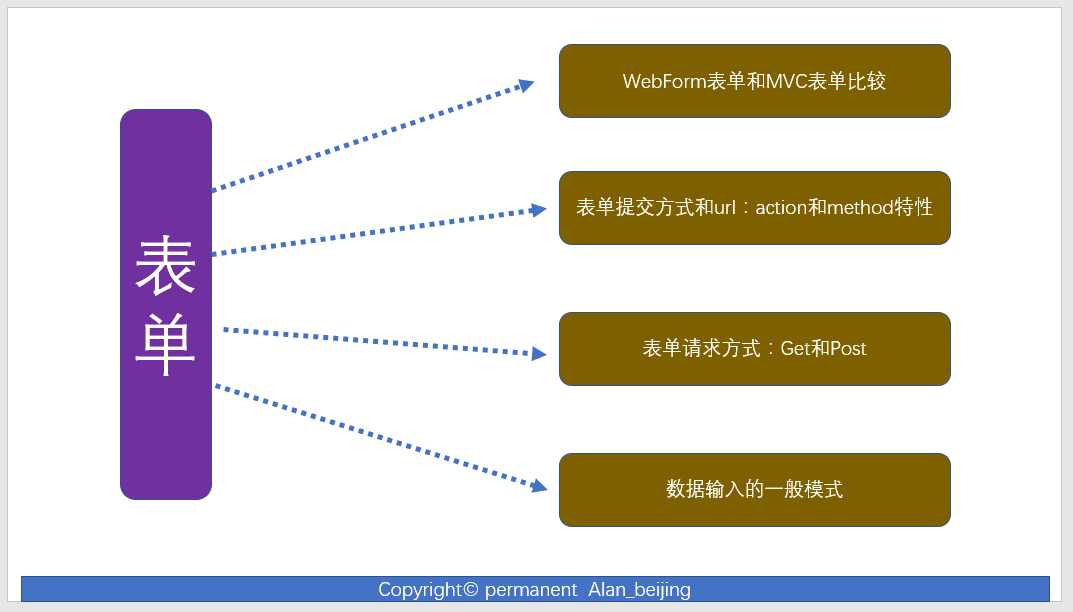
(一)WebForm表单与MVC表单比较
1.WebForm表单主要是利用其强大的<form>标签,而MVC并未完全利用<form>标签;
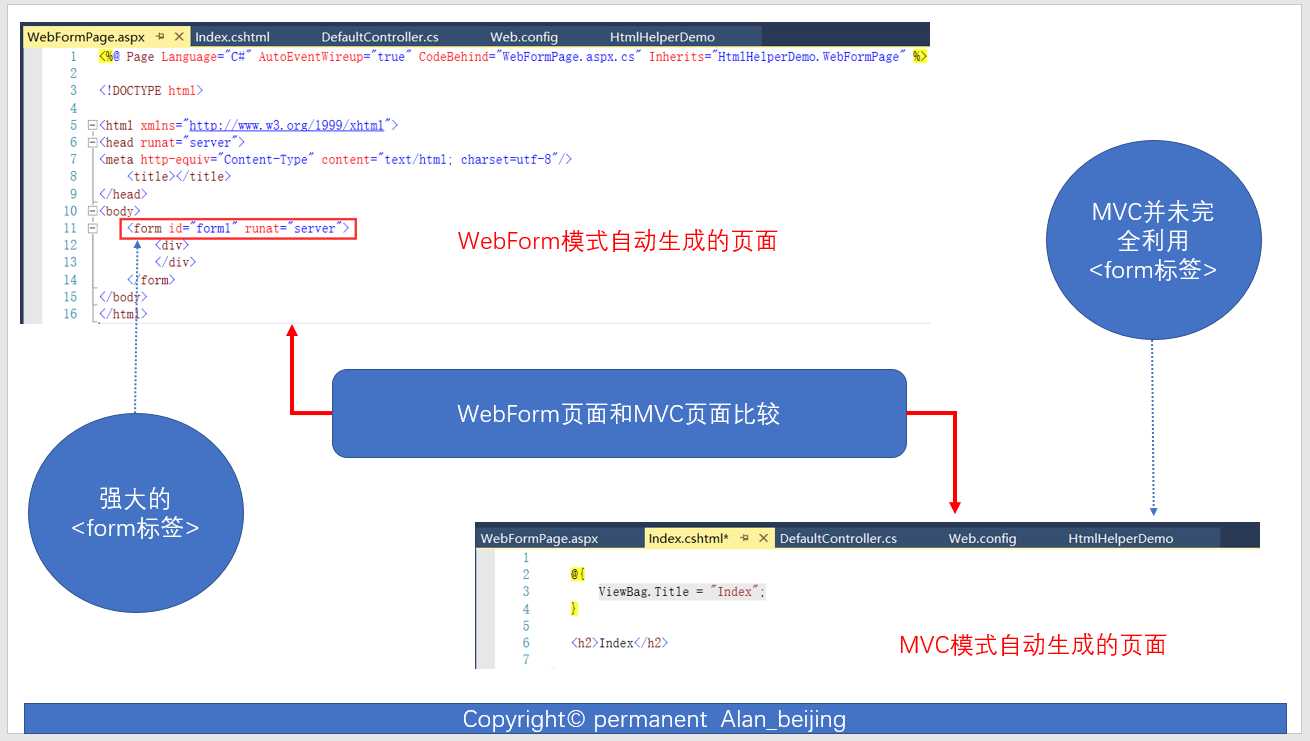
2.WebForm主要利用服务器端控件,MVC主要利用基于MVC基架的HTML辅助方法,两者都用HTML标签
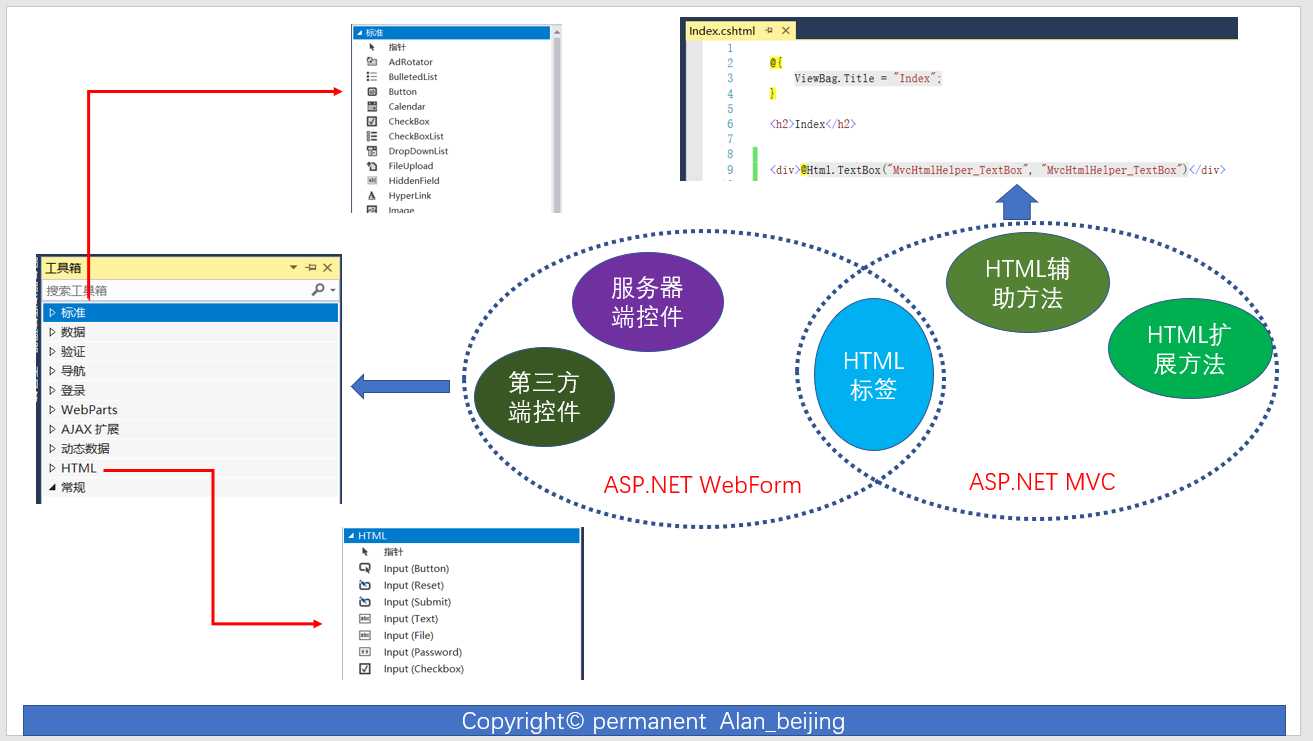
3.WebForm页面与后台代码强绑定,而MVC与后台代码松耦合
(1)WebForm中,每个页面对应一个类,页面泪继承Page类,我们称为页面类,如上图中Default页面对应的类为_Default,
(2)每个页面由三部分组成:前端代码(Default.aspx),后台代码(Default.aspx.cs)和设计器(Default.aspx.designer.cs);
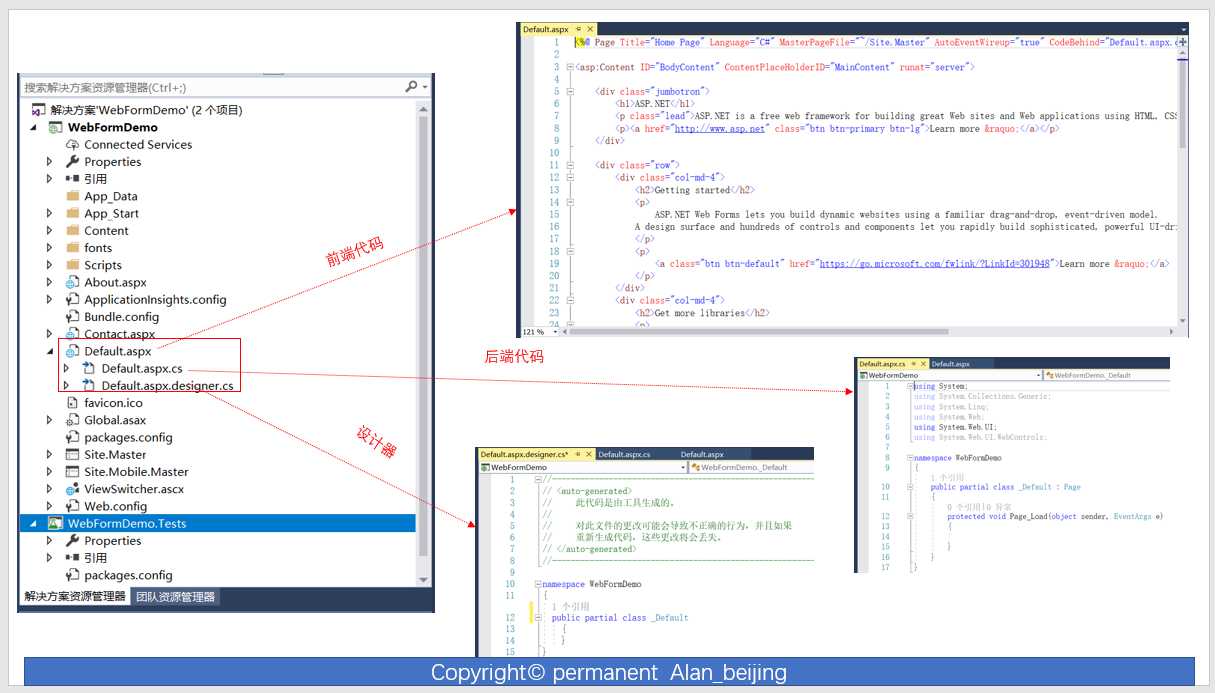
4.从性能上看,MVC比WebForm性能高。WebForm性能低的主要因素有如下几点:
(1)服务器端控件,消耗带宽,吃内存;
(2)ViewState垃圾数据;
(二)表单提交的方式和url:action和method特性
action和method为<form>标签两个重要的特性
(1)action:指将<form>标签提交到何处,本质就是一个url;
(2)method:提交form的方法,主要为post和get,默认为get;
(三)表单请求方式
表单请求方式,主要为post和get,默认为get;
(四)数据输入的一般模式
数据输入模式,一般分为两种模式:编辑-提交模式(Edit-and-Post)和选择-编辑-提交模式(Selct-Edit-Post)
三 HTML辅助方法
基于ASP.NET MVC基架的HTML辅助方法,大致分为内置HTM辅助方法(也叫基于MVC基架的HTML辅助方法)和自定义HTML辅助方法。
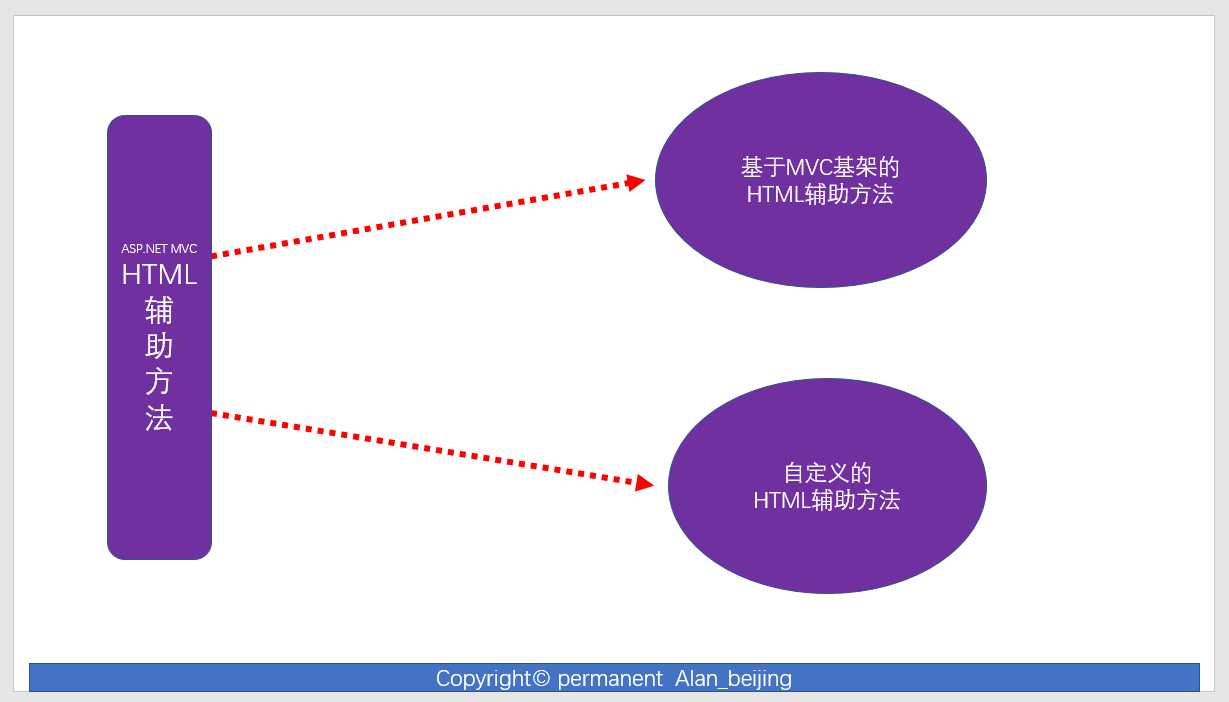
(一)基于MVC基架的HTML辅助方法
通过反汇编工具查看System.Web.Mvc.Html下的辅助方法,如下图所以。
由于基于MVC基架的辅方法比较简单,使用时只需调用即可,故本节不会花较大篇幅讲解,只是大致提及一下。
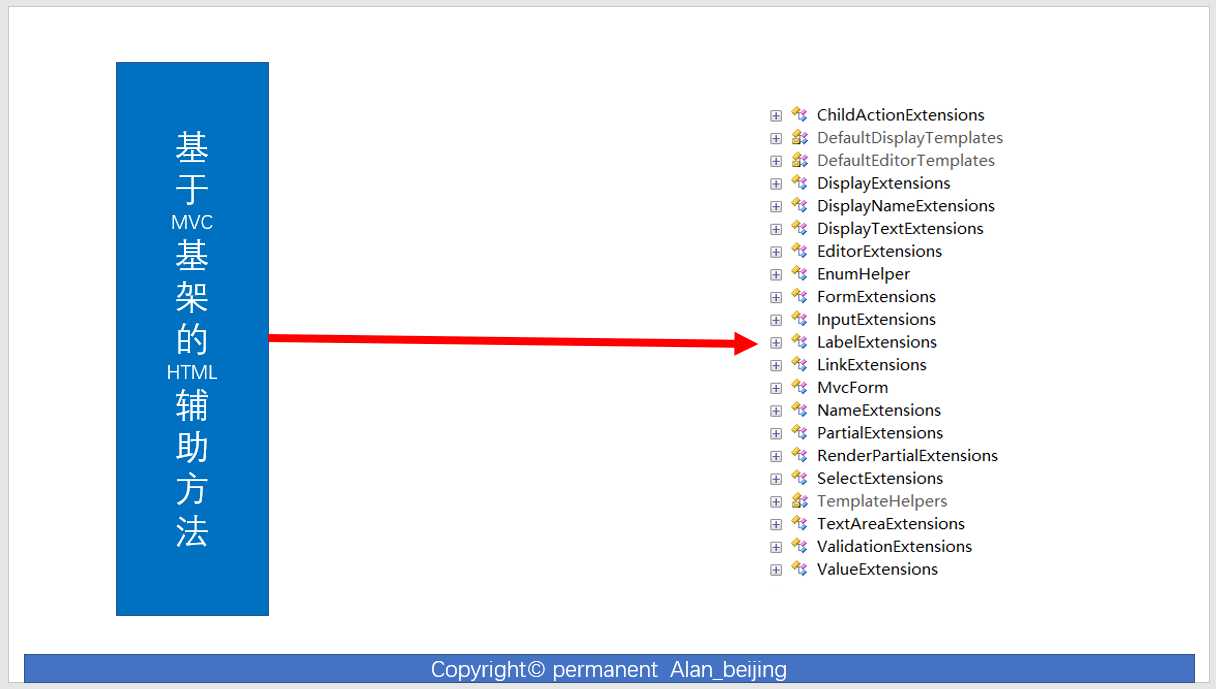
1.我们随便查看InputExtensions和LableExtensions辅助方法
InputExtensions
public static class InputExtensions { // Methods public static MvcHtmlString CheckBox(this HtmlHelper htmlHelper, string name); public static MvcHtmlString CheckBox(this HtmlHelper htmlHelper, string name, bool isChecked); public static MvcHtmlString CheckBox(this HtmlHelper htmlHelper, string name, IDictionary<string, object> htmlAttributes); public static MvcHtmlString CheckBox(this HtmlHelper htmlHelper, string name, object htmlAttributes); public static MvcHtmlString CheckBox(this HtmlHelper htmlHelper, string name, bool isChecked, IDictionary<string, object> htmlAttributes); public static MvcHtmlString CheckBox(this HtmlHelper htmlHelper, string name, bool isChecked, object htmlAttributes); public static MvcHtmlString CheckBoxFor<TModel>(this HtmlHelper<TModel> htmlHelper, Expression<Func<TModel, bool>> expression); public static MvcHtmlString CheckBoxFor<TModel>(this HtmlHelper<TModel> htmlHelper, Expression<Func<TModel, bool>> expression, IDictionary<string, object> htmlAttributes); public static MvcHtmlString CheckBoxFor<TModel>(this HtmlHelper<TModel> htmlHelper, Expression<Func<TModel, bool>> expression, object htmlAttributes); private static MvcHtmlString CheckBoxHelper(HtmlHelper htmlHelper, ModelMetadata metadata, string name, bool? isChecked, IDictionary<string, object> htmlAttributes); public static MvcHtmlString Hidden(this HtmlHelper htmlHelper, string name); public static MvcHtmlString Hidden(this HtmlHelper htmlHelper, string name, object value); public static MvcHtmlString Hidden(this HtmlHelper htmlHelper, string name, object value, IDictionary<string, object> htmlAttributes); public static MvcHtmlString Hidden(this HtmlHelper htmlHelper, string name, object value, object htmlAttributes); public static MvcHtmlString HiddenFor<TModel, TProperty>(this HtmlHelper<TModel> htmlHelper, Expression<Func<TModel, TProperty>> expression); public static MvcHtmlString HiddenFor<TModel, TProperty>(this HtmlHelper<TModel> htmlHelper, Expression<Func<TModel, TProperty>> expression, IDictionary<string, object> htmlAttributes); public static MvcHtmlString HiddenFor<TModel, TProperty>(this HtmlHelper<TModel> htmlHelper, Expression<Func<TModel, TProperty>> expression, object htmlAttributes); private static MvcHtmlString HiddenHelper(HtmlHelper htmlHelper, ModelMetadata metadata, object value, bool useViewData, string expression, IDictionary<string, object> htmlAttributes); private static MvcHtmlString InputHelper(HtmlHelper htmlHelper, InputType inputType, ModelMetadata metadata, string name, object value, bool useViewData, bool isChecked, bool setId, bool isExplicitValue, string format, IDictionary<string, object> htmlAttributes); public static MvcHtmlString Password(this HtmlHelper htmlHelper, string name); public static MvcHtmlString Password(this HtmlHelper htmlHelper, string name, object value); public static MvcHtmlString Password(this HtmlHelper htmlHelper, string name, object value, IDictionary<string, object> htmlAttributes); public static MvcHtmlString Password(this HtmlHelper htmlHelper, string name, object value, object htmlAttributes); public static MvcHtmlString PasswordFor<TModel, TProperty>(this HtmlHelper<TModel> htmlHelper, Expression<Func<TModel, TProperty>> expression); public static MvcHtmlString PasswordFor<TModel, TProperty>(this HtmlHelper<TModel> htmlHelper, Expression<Func<TModel, TProperty>> expression, IDictionary<string, object> htmlAttributes); public static MvcHtmlString PasswordFor<TModel, TProperty>(this HtmlHelper<TModel> htmlHelper, Expression<Func<TModel, TProperty>> expression, object htmlAttributes); private static MvcHtmlString PasswordHelper(HtmlHelper htmlHelper, ModelMetadata metadata, string name, object value, IDictionary<string, object> htmlAttributes); public static MvcHtmlString RadioButton(this HtmlHelper htmlHelper, string name, object value); public static MvcHtmlString RadioButton(this HtmlHelper htmlHelper, string name, object value, bool isChecked); public static MvcHtmlString RadioButton(this HtmlHelper htmlHelper, string name, object value, IDictionary<string, object> htmlAttributes); public static MvcHtmlString RadioButton(this HtmlHelper htmlHelper, string name, object value, object htmlAttributes); public static MvcHtmlString RadioButton(this HtmlHelper htmlHelper, string name, object value, bool isChecked, IDictionary<string, object> htmlAttributes); public static MvcHtmlString RadioButton(this HtmlHelper htmlHelper, string name, object value, bool isChecked, object htmlAttributes); public static MvcHtmlString RadioButtonFor<TModel, TProperty>(this HtmlHelper<TModel> htmlHelper, Expression<Func<TModel, TProperty>> expression, object value); public static MvcHtmlString RadioButtonFor<TModel, TProperty>(this HtmlHelper<TModel> htmlHelper, Expression<Func<TModel, TProperty>> expression, object value, IDictionary<string, object> htmlAttributes); public static MvcHtmlString RadioButtonFor<TModel, TProperty>(this HtmlHelper<TModel> htmlHelper, Expression<Func<TModel, TProperty>> expression, object value, object htmlAttributes); private static MvcHtmlString RadioButtonHelper(HtmlHelper htmlHelper, ModelMetadata metadata, object model, string name, object value, bool? isChecked, IDictionary<string, object> htmlAttributes); public static MvcHtmlString TextBox(this HtmlHelper htmlHelper, string name); public static MvcHtmlString TextBox(this HtmlHelper htmlHelper, string name, object value); public static MvcHtmlString TextBox(this HtmlHelper htmlHelper, string name, object value, IDictionary<string, object> htmlAttributes); public static MvcHtmlString TextBox(this HtmlHelper htmlHelper, string name, object value, object htmlAttributes); public static MvcHtmlString TextBox(this HtmlHelper htmlHelper, string name, object value, string format); public static MvcHtmlString TextBox(this HtmlHelper htmlHelper, string name, object value, string format, IDictionary<string, object> htmlAttributes); public static MvcHtmlString TextBox(this HtmlHelper htmlHelper, string name, object value, string format, object htmlAttributes); public static MvcHtmlString TextBoxFor<TModel, TProperty>(this HtmlHelper<TModel> htmlHelper, Expression<Func<TModel, TProperty>> expression); public static MvcHtmlString TextBoxFor<TModel, TProperty>(this HtmlHelper<TModel> htmlHelper, Expression<Func<TModel, TProperty>> expression, IDictionary<string, object> htmlAttributes); public static MvcHtmlString TextBoxFor<TModel, TProperty>(this HtmlHelper<TModel> htmlHelper, Expression<Func<TModel, TProperty>> expression, object htmlAttributes); public static MvcHtmlString TextBoxFor<TModel, TProperty>(this HtmlHelper<TModel> htmlHelper, Expression<Func<TModel, TProperty>> expression, string format); public static MvcHtmlString TextBoxFor<TModel, TProperty>(this HtmlHelper<TModel> htmlHelper, Expression<Func<TModel, TProperty>> expression, string format, IDictionary<string, object> htmlAttributes); public static MvcHtmlString TextBoxFor<TModel, TProperty>(this HtmlHelper<TModel> htmlHelper, Expression<Func<TModel, TProperty>> expression, string format, object htmlAttributes); private static MvcHtmlString TextBoxHelper(this HtmlHelper htmlHelper, ModelMetadata metadata, object model, string expression, string format, IDictionary<string, object> htmlAttributes); private static RouteValueDictionary ToRouteValueDictionary(IDictionary<string, object> dictionary); }
LableExtensions
public static class LabelExtensions { // Methods public static MvcHtmlString Label(this HtmlHelper html, string expression); public static MvcHtmlString Label(this HtmlHelper html, string expression, IDictionary<string, object> htmlAttributes); public static MvcHtmlString Label(this HtmlHelper html, string expression, object htmlAttributes); public static MvcHtmlString Label(this HtmlHelper html, string expression, string labelText); public static MvcHtmlString Label(this HtmlHelper html, string expression, string labelText, IDictionary<string, object> htmlAttributes); public static MvcHtmlString Label(this HtmlHelper html, string expression, string labelText, object htmlAttributes); internal static MvcHtmlString Label(this HtmlHelper html, string expression, string labelText, IDictionary<string, object> htmlAttributes, ModelMetadataProvider metadataProvider); internal static MvcHtmlString Label(this HtmlHelper html, string expression, string labelText, object htmlAttributes, ModelMetadataProvider metadataProvider); public static MvcHtmlString LabelFor<TModel, TValue>(this HtmlHelper<TModel> html, Expression<Func<TModel, TValue>> expression); public static MvcHtmlString LabelFor<TModel, TValue>(this HtmlHelper<TModel> html, Expression<Func<TModel, TValue>> expression, IDictionary<string, object> htmlAttributes); public static MvcHtmlString LabelFor<TModel, TValue>(this HtmlHelper<TModel> html, Expression<Func<TModel, TValue>> expression, object htmlAttributes); public static MvcHtmlString LabelFor<TModel, TValue>(this HtmlHelper<TModel> html, Expression<Func<TModel, TValue>> expression, string labelText); public static MvcHtmlString LabelFor<TModel, TValue>(this HtmlHelper<TModel> html, Expression<Func<TModel, TValue>> expression, string labelText, IDictionary<string, object> htmlAttributes); public static MvcHtmlString LabelFor<TModel, TValue>(this HtmlHelper<TModel> html, Expression<Func<TModel, TValue>> expression, string labelText, object htmlAttributes); internal static MvcHtmlString LabelFor<TModel, TValue>(this HtmlHelper<TModel> html, Expression<Func<TModel, TValue>> expression, string labelText, IDictionary<string, object> htmlAttributes, ModelMetadataProvider metadataProvider); internal static MvcHtmlString LabelFor<TModel, TValue>(this HtmlHelper<TModel> html, Expression<Func<TModel, TValue>> expression, string labelText, object htmlAttributes, ModelMetadataProvider metadataProvider); public static MvcHtmlString LabelForModel(this HtmlHelper html); public static MvcHtmlString LabelForModel(this HtmlHelper html, IDictionary<string, object> htmlAttributes); public static MvcHtmlString LabelForModel(this HtmlHelper html, object htmlAttributes); public static MvcHtmlString LabelForModel(this HtmlHelper html, string labelText); public static MvcHtmlString LabelForModel(this HtmlHelper html, string labelText, IDictionary<string, object> htmlAttributes); public static MvcHtmlString LabelForModel(this HtmlHelper html, string labelText, object htmlAttributes); internal static MvcHtmlString LabelHelper(HtmlHelper html, ModelMetadata metadata, string htmlFieldName, string labelText = null, IDictionary<string, object> htmlAttributes = null); }
2.在ASP.NET MVC5 高级编程(Jon Galloway,Brad Wilson,K.Scott Allen,David Matson 著 ,孙远帅 译) 中,作者将HTML辅助方法大致分为下图几类

(二)自定义的HTML辅助方法
关于自定义HTML辅助方法,主要从下图五个角度讲解。

1.为什么要扩展辅助方法
(1)何为扩展?
从汉语字面意义理解,即在现有的基础上进行修改(修改现有辅助方法)、增加(自定义MVC基架没有的辅助方法)等操作。
(2)扩展的作用?
首先,从MVC基架现有的某些HTML辅助方法,其某些属性,如样式等无法满足现有需求,需要扩展;
其次,现有需求的某些辅助方法,如Image辅助辅助方法,File辅助方法等,MVC基架并未提供,需要扩展;
最后,扩展的最终目的是提高代码的复用,提高编码效率;
2.用反汇编工具查看MVC源码是如何扩展的
(1)我们查看MVC是如何定义强类型和弱类型的,以Html.Lable为例,我们容易得出三个结论:
1)程序集为System.Web.Mvc
2)命名空间为System.Web.Mvc.Html
3)弱类型方法名字直接为纯html对应名字
4)强类型方法名字=若类型名字+For
5)辅助方法的返回类型均为MvcHtmlString
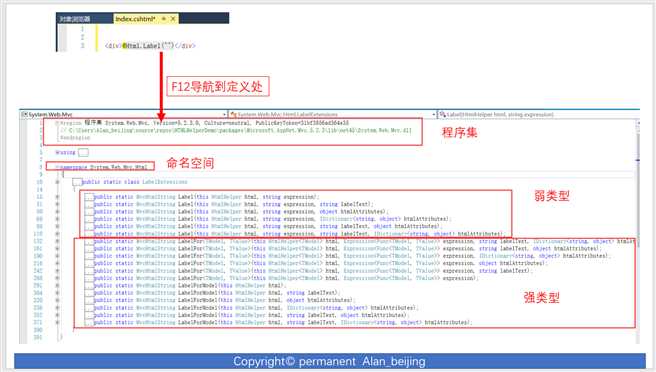
(2)我们用反汇编工具查看一下
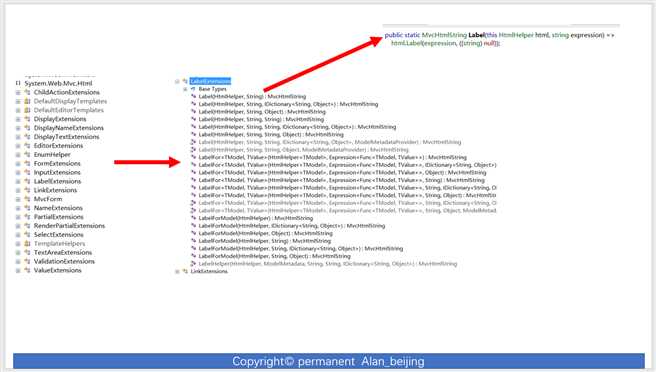
(3)总结
根据如上(1)(2)分析,我们知道定义一个HTML辅助方法的步骤
1)命名空间为System.Web.Mvc
2)弱类型方法名字直接为纯html对应名字
3)强类型方法名字=若类型名字+For
4)辅助方法的返回类型均为MvcHtmlString
3.扩展弱类型辅助方法
1 //Image弱类型 2 public static MvcHtmlString Image(this HtmlHelper helper, string id, string url, string width, string height, string alternateText, object htmlAttributes) 3 { 4 //创建img标签 5 TagBuilder imgTagBulider = new TagBuilder("img"); 6 7 //为img标签添加属性:id,url,alternateText,htmlAttributes 8 imgTagBulider.GenerateId(id); 9 imgTagBulider.MergeAttribute("src", url); 10 imgTagBulider.MergeAttribute("width", width); 11 imgTagBulider.MergeAttribute("height", height); 12 imgTagBulider.MergeAttribute("src", url); 13 imgTagBulider.MergeAttribute("alt", alternateText); 14 imgTagBulider.MergeAttributes(new RouteValueDictionary(htmlAttributes)); 15 16 // 输出img标签 17 return MvcHtmlString.Create(imgTagBulider.ToString()); 18 }
4.扩展强类型辅助方法
1 //Image强类型 2 public static MvcHtmlString ImageFor<TModel, TValue>(this HtmlHelper<TModel> html,Expression<Func<TModel,TValue>> expression,string url, string width, string height, string alternateText, Dictionary<TModel, TValue> htmlAttributes) 3 { 4 string modelName = ExpressionHelper.GetExpressionText(expression);//从Lambda表达式中获取模型对应属性的名称 5 //创建img标签 6 TagBuilder imgTagBulider = new TagBuilder("img"); 7 8 //为img标签添加属性:id,url,alternateText,htmlAttributes 9 imgTagBulider.GenerateId(modelName); 10 imgTagBulider.MergeAttribute("src", url); 11 imgTagBulider.MergeAttribute("width", width); 12 imgTagBulider.MergeAttribute("height", height); 13 imgTagBulider.MergeAttribute("src", url); 14 imgTagBulider.MergeAttribute("alt", alternateText); 15 imgTagBulider.MergeAttributes(new RouteValueDictionary(htmlAttributes)); 16 17 return MvcHtmlString.Create(imgTagBulider.ToString(TagRenderMode.SelfClosing)); 18 }
5.完整代码
Index.cshtml

1 @model HTMLHelperDemo.Models.UserInfo 2 3 4 <div>---------------Image弱类型扩展------------------</div> 5 <div>@Html.Image("ImageID", "/Images/hgspb.jpg", "300","300","自定义图片",null)</div> 6 <div>---------------Image强类型扩展------------------</div> 7 <div>@Html.ImageFor(m=>m.UserName, "/Images/hgspb.jpg", "300", "300", "自定义图片", null)</div> 8
DefaultController

1 using System; 2 using System.Collections.Generic; 3 using System.Linq; 4 using System.Web; 5 using System.Web.Mvc; 6 7 namespace HTMLHelperDemo.Controllers 8 { 9 public class DefaultController : Controller 10 { 11 // GET: Default 12 public ActionResult Index() 13 { 14 return View(); 15 } 16 } 17 }
MyHtmlHelperExtension.cs

1 using System; 2 using System.Collections.Generic; 3 using System.Linq; 4 using System.Web; 5 6 using System.Web.Routing; 7 using System.Linq.Expressions; 8 namespace System.Web.Mvc 9 { 10 public static class ImageExtensions 11 { 12 //Image弱类型 13 public static MvcHtmlString Image(this HtmlHelper helper, string id, string url, string width, string height, string alternateText, object htmlAttributes) 14 { 15 //创建img标签 16 TagBuilder imgTagBulider = new TagBuilder("img"); 17 18 //为img标签添加属性:id,url,alternateText,htmlAttributes 19 imgTagBulider.GenerateId(id); 20 imgTagBulider.MergeAttribute("src", url); 21 imgTagBulider.MergeAttribute("width", width); 22 imgTagBulider.MergeAttribute("height", height); 23 imgTagBulider.MergeAttribute("src", url); 24 imgTagBulider.MergeAttribute("alt", alternateText); 25 imgTagBulider.MergeAttributes(new RouteValueDictionary(htmlAttributes)); 26 27 // 输出img标签 28 return MvcHtmlString.Create(imgTagBulider.ToString()); 29 } 30 //Image强类型 31 public static MvcHtmlString ImageFor<TModel, TValue>(this HtmlHelper<TModel> html,Expression<Func<TModel,TValue>> expression,string url, string width, string height, string alternateText, Dictionary<TModel, TValue> htmlAttributes) 32 { 33 string modelName = ExpressionHelper.GetExpressionText(expression);//从Lambda表达式中获取模型对应属性的名称 34 //创建img标签 35 TagBuilder imgTagBulider = new TagBuilder("img"); 36 37 //为img标签添加属性:id,url,alternateText,htmlAttributes 38 imgTagBulider.GenerateId(modelName); 39 imgTagBulider.MergeAttribute("src", url); 40 imgTagBulider.MergeAttribute("width", width); 41 imgTagBulider.MergeAttribute("height", height); 42 imgTagBulider.MergeAttribute("src", url); 43 imgTagBulider.MergeAttribute("alt", alternateText); 44 imgTagBulider.MergeAttributes(new RouteValueDictionary(htmlAttributes)); 45 46 return MvcHtmlString.Create(imgTagBulider.ToString(TagRenderMode.SelfClosing)); 47 } 48 } 49 } 50 51
图解
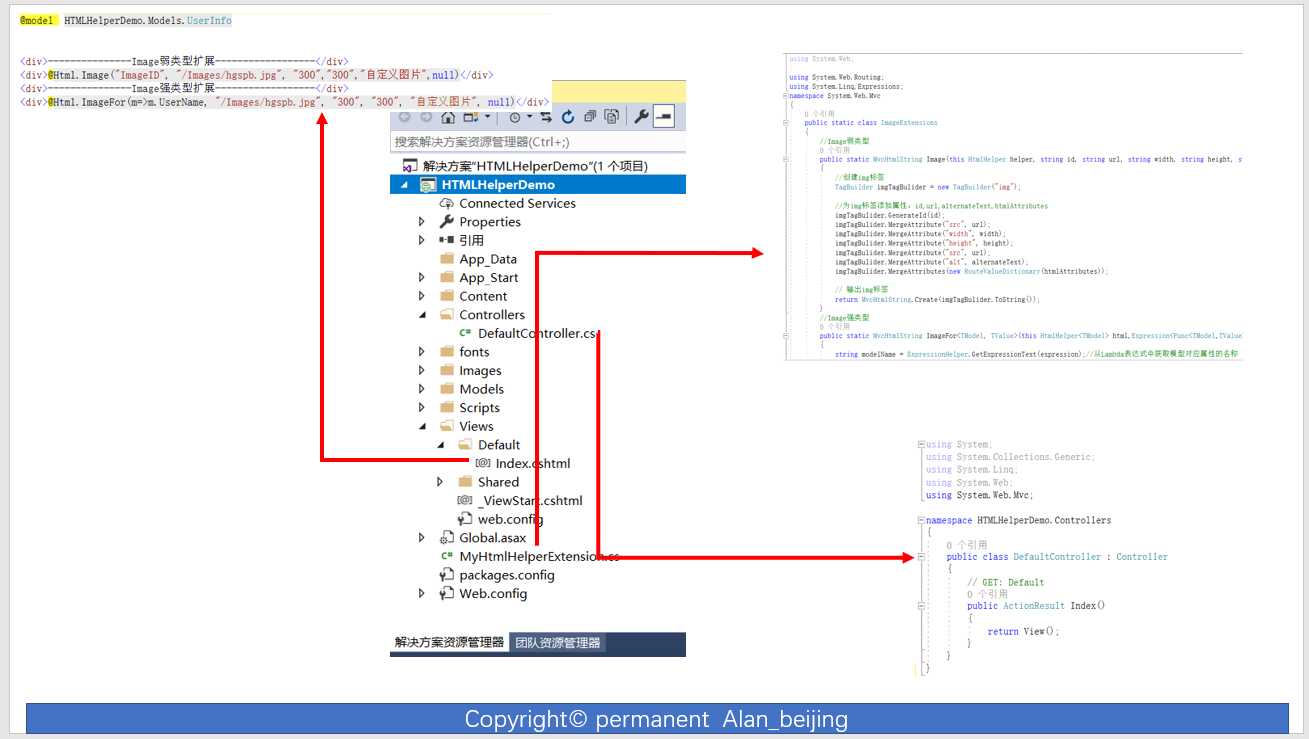
四 HTML辅助方法的工作原理
关于HTML辅助方法工做原理,这里不做深入研讨,只是描述一下工作原理的轮廓。
1.MVC中,View的后缀为.cshtml,我们可以将其拆分为:.cshtml=.cs+html,即由后台.cs代码+html标签构成;
2.既然View是由后台代码.cs+html标签构成,那么什么标签能满足这两个条件呢?HTML辅助方法。由此,我们知道HTML辅助方法扮演后台代码和前端HTML代码的中间者,桥梁;
3.既然HTML代码扮演后台代码和前端HTML桥梁,那么其与后台有哪些联系呢?
(1)与Model的联系,如HTML强辅助方法,使用Lambda表达式
(2)与Conteller联系,如Html.ActonLink
(3)与Route联系,如Html.RouteLink;
(4)与ModelState联系,如在验证输入值的合法性时,若验证错误,错误消息存在模型状态中,然后返回给Html相应的辅助方法
.......
4.我们知道了HTML辅助方法与后台的联系,那么与后台联系之后,接下来做什么呢?渲染成HTML,返回给浏览器
如上,我们大致分析了HTML辅助方法的工作原理步骤,下面我们将要的画图分析一下

四 参考文献
【01】C#高级编程(第七版) (Christian Nagel,Bill Evjen和Jay Glynn 编著,李铭 译,黄静 审校)
五 作者关于评论的建议
欢迎读者朋友们广提意见,您宝贵的意见,是我写作的动力。相互学习,共同进步!
(一) 关于文章内容
1.简单,回复1(请指出简单因素)
2.一般,回复2
3.适度,回复3
4.较难,回复4
5.很难,回复5(请指出很难因素)
(二) 文章讲解
1.一般,回复6
2.良好,回复7
3.易懂,回复8
4.复杂,回复9(请指出复杂因素)
(三) 关于其他意见
10.若有其他意见,在评论区评价即可;
11.关于评价内容,不好的评价内容(除人身攻击外),具有建设性建议的评价内容,一定保存
12.其他评价,有可能会被删除
六 版权区
- 感谢您的阅读,若有不足之处,欢迎指教,共同学习、共同进步。
- 博主网址:http://www.cnblogs.com/wangjiming/。
- 极少部分文章利用读书、参考、引用、抄袭、复制和粘贴等多种方式整合而成的,大部分为原创。
- 如您喜欢,麻烦推荐一下;如您有新想法,欢迎提出,邮箱:2098469527@qq.com。
- 可以转载该博客,但必须著名博客来源。

